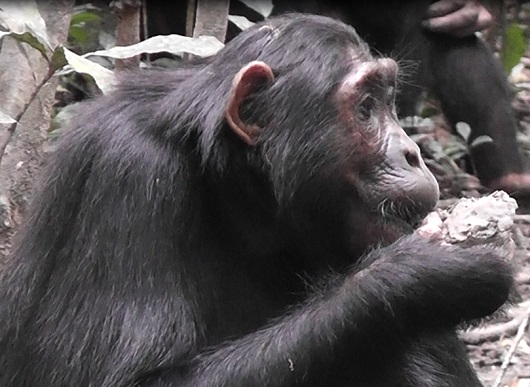Have you had your clay this morning?

Wild chimpanzees in the Budongo forest supplement the minerals in their diet by eating clay soils, according to a long-term study involving researchers at the University of St Andrews and published in journal PLoS One today (Tuesday 28 July, 2015).
In the new report, researchers describe a range of ways wild chimpanzees in the Budongo forest, Uganda, supplement the minerals in their diet by eating clay and the soil from termite mounds, as well as drinking water from clay-pits.
St Andrews researchers Dr Cat Hobaiter, Ms Brittany Fallon and Prof Klaus Zuberbühler contributed their observations to a 25-year-long study of the Budongo chimpanzees.
The clay and termite soils were found to be high in a range of minerals, but clay was particularly high in Aluminium – a feature of kaolinite clays eaten by a range of species, including humans, to aid digestion and detoxification. Chimpanzee diets are very high in tannins and it may be that the clay provides an important way for chimpanzees to neutralize these.
Clay soil feeding in Budongo seems to have increased over recent years, possibly because of the widespread destruction of the raphia-palm tree, previously an important source of minerals for the Budongo chimpanzees, but now used in the local tobacco industry.
Raffia is a key source of sodium, but lead author Vernon Reynolds, Emeritus Professor at Oxford University, explains: “To our surprise the sodium content was very low, so this was not the reason for the new ‘clay-bingeing’; instead the wide range of minerals present suggest that it is eaten as a general mineral supplement.”
University of St Andrews primatologist Dr Cat Hobaiter commented: “Chimpanzees are often thought of as being very conservative, and the destruction of their natural feeding species can be hugely problematic. It’s fascinating to see that Budongo chimps may compensate for the loss of one major source of minerals in their diet by increasing their use of alternatives like the clay.
“The highest levels of minerals were found in the clay contained in leaf-sponges. Chimpanzees use these leaf-tools to drink the water from ground and tree holes in the forest. We know that clay can increase the bioactive properties of leaves in chimpanzee diets and it seems that the Budongo chimpanzees have capitalized on this – sponging up extra minerals with their leaf-tools.”
Notes to news editors
The paper ‘Mineral acquisition from clay by Budongo Forest chimpanzees’ by Vernon Reynolds et al will be published by PLoS ONE. It is strictly embargoed until 2pm ET (7pm BST).
Images and video are available from the press office – contact 01334 462 530 or email [email protected]
Researchers can be contacted via:
Dr Hobaiter: email [email protected] or twitter @nakedprimate
Professor Zuberbühler: email [email protected]
Category Research